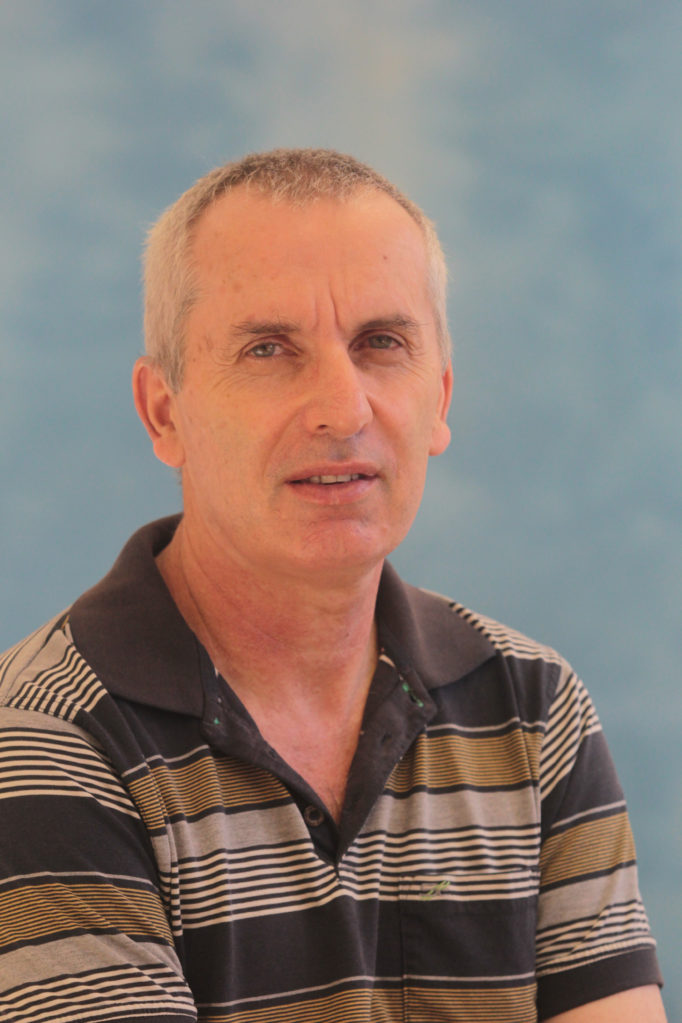Simon Brandon
Personal Info
Ph.D. 1992, University of MinnesotaResearch Fields
Processes, Surface-PhenomenaResearch Topics
Sophisticated Computational Tools
In recent years we have developed sophisticated computational tools for two-and-three dimensional multiple-length-scale analysis of combined transport phenomena and interface attachment kinetics (associated with facetted growth) in large scale melt and solution growth systems. Among other things we are focusing our attention on solution growth systems in which faceting is prevalent. Applications include very large crystals for nonlinear optical devices, as well as small scale crystals to be used in pharmaceutical applications or for structure determination of proteins. We wish to investigate possible defect-generating mechanisms related to coupling between meso-scale surface phenomena and macro-scale solute transport. In addition, we aim to increase the realistic-nature of macro-scale solution flow phenomena to better-understand the impact of actual flow in real systems on crystalline quality.
Crystal Growth
Although many aspects of crystal growth can be related to macro or meso length scale phenomena, the fundamental crystal growth event involves the incorporation of molecular-scale growth units into an evolving crystal/fluid interface. Experimental studies have, in recent years, uncovered a rich variety of molecular level events occurring during crystal growth from the vapor and solution phases. In particular, Atomic Force Microscope studies of protein crystal growth from aqueous solutions have uncovered mechanisms for defect formation, new mechanisms of crystal growth and more. We have, in the past few years, been working on the analysis of protein crystal growth from solution via molecular simulation techniques. Attempts are being made to link model potential parameter values, equilibrium phase behavior and molecular scale crystal growth phenomena.
Thermal Batteries
Thermal batteries operate using a molten salt electrolyte. This is achieved (once only per battery) by igniting pyrotechnic material which raises the temperature above the electrolyte’s melting point thus facilitating battery discharge. The life-time of the battery is often determined by the ability of thermal insulation to keep the system’s temperature above the melting point of the salt. We (in collaboration with a colleague from industry) have developed a versatile simulator for the analysis and design of thermal batteries. This can be applied to a wide range of cylindrical geometries with flexible inner structure related to the number and type of elechtrochemical cells as well as insulating material geometries. Thus far, our thermal model has predicted realistic operating times while accounting for phase-change effects in the eutectic electrolyte material. We have achieved (for the first time) a quantitative analysis of the importance of heat of solidification release during cool down as well as the relative importance of joule heating and (endothermic) heats of reaction during the operation of a typical battery.
Solid-liquid-gas three-phase contact lines
Solid-liquid-gas three-phase contact lines are often significantly important in materials processing systems involving heat and mass transport between the different phases. Interfacial energies (with or without anisotropic effects) as well as transport phenomena in the vicinity of the contact line may strongly impact the process. Our recent work, involving a model solidifying drop system, is related to the quantitative determination of boundary conditions at the contact line as well as to the investigation of the impact of different phenomena on the evolving solid’s geometry.
Publications
N. Haimovich, D.R. Dekel and S. Brandon, A simulator for system-level analysis of heat transfer and phase-change in thermal batteries I: Computational approach and single cell calculations, J. Electrochem. Soc., 156(6), A442-A453 (2009).
I.G. Rasin, O. Weinstein and S. Brandon, `Modeling the impact of flow modulation on surface structure during the growth of potassium dihydrogen phosphate single crystals from solution, Int. J. Multiscale Comp. Eng. 6(6), 585-601 (2008).
A. Virozub, I.G. Rasin and S. Brandon, Revisiting the constant growth angle: Estimation and verification via rigorous thermal modeling, J. Crystal Growth, 310, 5416-5422 (2008).
S. Brandon, P. Katsonis, and P.G. Vekilov, Multiple extrema in the intermolecular potential and the phase diagram of protein solutions, Phys. Rev. E., 73(6-1), 061917/1-061917/9 (2006).
O. Weinstein and S. Brandon, Dynamics of partially faceted melt/crystal interfaces III: three-dimensional computational approach and calculations,’ J. Crystal Growth, 284, 235-253 (2005).
O. Weinstein and S. Brandon, Dynamics of partially faceted melt/crystal interfaces II: multiple step- source calculations, J. Crystal Growth, 270(1-2), 232-249 (2004).
S. Brandon, N. Haimovich, E. Yeger, and A. Marmur, Partial wetting of chemically patterned surfaces: The effect of drop size, J. Colloid Interf. Sci., 263(1), 237-243 (2003).
S. Brandon and J.J. Derby, Heat transfer in vertical Bridgman growth of oxides: effects of conduction, convection and internal radiation, J. Crystal Growth, 121(3), 473-494 (1992(.
Simon Brandon
